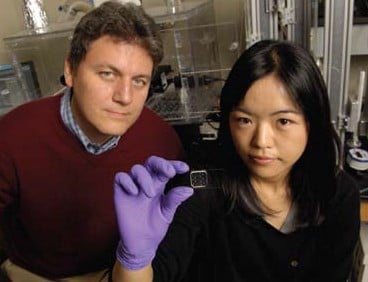
A new “lab on a chip” developed by Whiting School engineers will make it easier to study how and why neurons grow the way they do.
For nerve cells to function properly they have to make the right connections. To do this, they follow their noses, making their ways to their final destinations guided by complex chemical cues. But it has been difficult to study how these chemical cues work in the lab.
If you grow the neuron in a liquid medium, shearing forces from tiny currents tend to affect growth or damage the cell. And it can be hard to control the amount and the gradient of the chemical signals you want to study.
Now Andre Levchenko, associate professor of biomedical engineering, has created a “lab on a chip”—a micro-scale tool designed to mimic the chemical complexities of the brain—that allows nerve cell growth to be precisely controlled and studied.
“The current state of the art is rather crude. People use micropipettes, which they bring very close to a growth cone, and try to dump out a little bit of soluble cue. It’s not a very precise technique, and it doesn’t allow multiple cues. It’s also not high throughput,” Levchenko says. “We wanted to design a device that would allow us to put living neurons into it. We want- ed to subject neurons to different cues and multiple cues at the same time.”
To create the chip, Levchenko and his colleagues used a photolithographic technique similar to that used to make silicon computer chips. They etched the pattern they wanted into a silicon wafer, and used the wafer as a mold to cast the plastic. When they were done, they had a plastic chip full of tiny channels and wells. Using computer-controlled valves, they could precisely control the flow of nutrients and chemical signals throughout the chip.
For the experiment, the researchers implanted embryonic spinal nerve cells from the African frog Xenopus in the wells in the chip. Some of the channels were coated with chemical cues. Other chemical cues were introduced in solution.
The entire device was mounted under a powerful microscope. As the cell grew, the researchers were able to watch how it responded to the chemical cues on the channel walls, and also see how other cues they introduced affected the growth.
They were especially interested in how two different chemical cues might interact. They found that one chemical on a surface could attract the neuron to grow toward it, and another in solution could do the same. But when exposed to both cues at the same time, the cell grew in a random fashion.
Levchenko says that the chip will allow researchers to continue to examine how chemical cues affect neuron growth. It could be especially helpful in studying how neurons regenerate after an injury, and could also have applications for drug discovery.
“It’s a wonderful tool,” he says.




